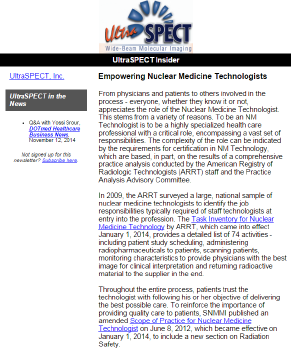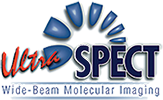 Empowering Nuclear Medicine Technologists
Empowering Nuclear Medicine Technologists
From physicians and patients to others involved in the process - everyone, whether they know it or not, appreciates the role of the Nuclear Medicine Technologist. This stems from a variety of reasons. To be an NM Technologist is to be a highly specialized health care professional with a critical role, encompassing a vast set of responsibilities. The complexity of the role can be indicated by the requirements for certification in NM Technology, which are based, in part, on the results of a comprehensive practice analysis conducted by the American Registry of Radiologic Technologists (ARRT) staff and the Practice Analysis Advisory Committee.
In 2009, the ARRT surveyed a large, national sample of nuclear medicine technologists to identify the job responsibilities typically required of staff technologists at entry into the profession. The Task Inventory for Nuclear Medicine Technology by ARRT, which came into effect January 1, 2014, provides a detailed list of 74 activities - including patient study scheduling, administering radiopharmaceuticals to patients, scanning patients, monitoring characteristics to provide physicians with the best image for clinical interpretation and returning radioactive material to the supplier in the end.
Throughout the entire process, patients trust the technologist with following his or her objective of delivering the best possible care. To reinforce the importance of providing quality care to patients, SNMMI published an amended Scope of Practice for Nuclear Medicine Technologist on June 8, 2012, which became effective on January 1, 2014, to include a new section on Radiation Safety.
The updated section encouraged 'practicing techniques that will minimize radiation exposure to the patient, health care personnel and general public, through consistent use of protective devices, shields, and monitors consistent with ALARA (as low as reasonably achievable) and establishing protocols for managing spills and unplanned releases of radiation.'
In light of the amendment, Nuclear Medicine Technologists are now pressed to ensure, among their several responsibilities, that patients are receiving the safest standard of care. The push for improvement to care quality, especially in terms of radiation dose to patients, is one that continues to grow in momentum. Thankfully, for the busy yet ever-dedicated Technologist, there are available technologies that can be adopted to support lower dose techniques. These include stress-only protocols, CZT solid state cameras and UltraSPECT solutions, powered by wide-beam reconstruction technology.
At the end of the day, the valuable and complex role of the Nuclear Medicine Technologist can be supported by all the aforementioned options - but UltraSPECT remains the most cost-effective. Additionally, our solutions bring the potential to revitalize existing cameras to ensure all NM Technologists at a facility can practice low dose techniques with patients. Innovation in Nuclear Medicine must not only help make tasks easier for Technologists, it should empower them in their overall role.
In the quest for reduced radiation dose in nuclear medicine, every component and participant of the process is important - and today, we applaud Technologists and all that they do. Here's to our joint efforts and collaboration for a future of enhanced, safer care delivery.
Regards,
Yossi
PARTNERS
|
Success is not achieved alone, and for UltraSPECT, we value the partners who embrace our passion and commitment to lower the dose. So this month we'd like to take the opportunity to collectively showcase the many organizations with which UltraSPECT has formed valuable partnerships. From pharmacy providers to equipment resellers and service providers, our relationships are with companies representing the various sectors in Nuclear Medicine imaging. Aligned under one primary objective - the increased availability of safer, low dose imaging in nuclear medicine - we are making a difference together.
Refurbished Equipment & Service Providers
Turnkey Solution & Service Providers
Radiopharmaceutical Suppliers
|
5 Questions with Mark Hyun

Meet Mark Hyun, CNMT, NCT, RT(N,R,CT), FASNC, Nuclear Medicine, Cardiac CT & Research Specialist at Cedars-Sinai Medical Center, who has over thirty years of experience in the industry and was a recipient of UltraSPECT's ASNC Technologist Travel Award in 2014.
Tell us about your beginnings in Nuclear Medicine and your journey in the field so far.
Well, it's been quite the journey! In my career, I've felt like things have changed dramatically from one moment to the next over the last thirty years. I was born and raised in Korea, with dreams of becoming a medical doctor since I was in high school. A major transition occurred in my life when my father decided to move the family to the United States to seek better treatment options for my mother, who was diagnosed with ALS. It was a big sacrifice for my father and a big change for me and my two younger brothers. Still, there was an opportunity for a better education for us and a good part of my extended family was already settled in the U.S., which helped the transition.
Having arrived here after completing high school in Korea, I consulted with uncles, aunts and other family members on how to pursue my goals of going to medical school and making a living in this country. After a number of discussions, I made the decision to join the U.S. Army in 1978. After three years of active duty, I returned home and once again began to focus on my education.
Since I wasn't a foreign exchange student or a high school graduate here in the States, I needed an alternate path to entering college. So, I entered a pre-med program at a community college and gathered enough credit to transfer and enroll at the School of Radiologic Technology in University of Southern California. There, I grew and intrigued by Nuclear Medicine, as I found it to be technically challenging beyond the conventional medical tracks. This was where I got into the field, after going through programs to become an X-Ray and Nuclear Medicine Technologist. Upon my graduation, I found a job at Cedars-Sinai, where I began my career at 1986.
I was in that role for nearly fifteen years, where I had the opportunity to take on a number of roles, including positions in supervisory/technical management and administrative management. I was essentially running the show - developing programs, validating and reprocessing while also managing and coordinating clinical responsibilities. Research, however, was the backbone of my career in nuclear cardiology and also one of my major passions.
Another passion for me was my family. In 2001, I moved on to another role to be able to spend more time with my wife and kids - this time in an outpatient imaging center, where I was able to work with a well renowned nuclear cardiologist in the industry, which was very rewarding. After a few years in that position, I was faced with another transition - as 2008 brought significant changes to the healthcare landscape and major cuts in reimbursement. This led me to my most recent role, which came as a result of an opportunity I received to return to Cedars-Sinai, primarily in a research capacity.
So, as of 2010, I have been in a specialist position at the same organization where I began my career, this time focusing on the maintenance of remote lab activity and the reporting of findings and research to support health physicists at the hospital. In addition, I was involved in and promoting the success in inclining demand in Cardiac CT imaging, utilizing my X-ray and CT imaging capacity in conjunction with my nuclear cardiology technical expertise.
Perhaps this has been a long story - but I've had quite an interesting time in this field!
What advice would you give to individuals entering this field?
I'll preface my answer with some background first. As I mentioned before, I'd had previous experience as an X-Ray technologist. I've leveraged that background recently to add 'cardiac CT technologist' to my repertoire, as the cardiac imaging department here takes on quite a bit of multi-modality imaging. Why? Well, in our industry, we are seeing that the volume of exams in nuclear cardiology have decreased, while other modalities for cardiac imaging have seen an increase.
Multi-modality imaging is efficient. And efficiency is the future. When I have the opportunity to mentor students at our facility, I give them the same advice I'd give to all individuals entering this field: focus on integrating efficiency and versatility into your background. It's important to gather experience, knowledge and technical skills in Nuclear Medicine but also areas that build your familiarity and expertise in multi-modality imaging.
This helps in being prepared to evolve as technologies evolve. There are programs available that include nuclear cardiology, nuclear medicine therapy, multi-modality, PET/CT, SPECT/CT, PET/MR and more - all designed to equip those entering Nuclear Medicine with the necessary skills to become high-value assets in their careers.
What would you say the future holds for Nuclear Medicine?
The bigger picture and multi-modality may be the way of the future, but Nuclear Medicine will also definitely become a more recognized field, because doctors need us. Physicians need information both anatomically, through CTs and MRIs, and physiologic-functionally, through Nuclear Medicine. At the end of the day, having both components is incredibly important to the decision-making process on how to treat patients.
We want to provide the best possible care to our patients, which is why the one-size-fits-all approach is no longer a reality. Each patient is different and we are tailoring the care they receive to support positive outcomes. For Nuclear Medicine, the future is more efficient and radiation-sensitive - ensuring that we expose patients to as little radiation as possible while maximizing the ability for software and hardware to define the state of diagnosis and offer important prognostic information.
Tell us about your history with UltraSPECT.
During my time at the outpatient imaging center I previously mentioned, we were introduced to UltraSPECT technology for half-time acquisition imaging. We actually did a year's worth of evaluation where we collected data from usage and assessed our reading with and without the solution.
We had the opportunity to experience cutting scan times in half or down to a quarter of what they were previously. We were able to do the same with radiation dose, or even cut down on both. We were very surprised by seeing a solution that made our scanner quicker and better while using less radiation!
Following our experiences with UltraSPECT, we wound up helping some of the remote labs begin to utilize the technology as well, with some facilities fully adopting the solution as a permanent part of their routine process.
Patients have had a great reaction to UltraSPECT as well - especially for those who have been visiting our facilities for many years, who genuinely feel the difference when no longer having to sit around for a long time for a Nuclear Medicine exam. The added benefit of lowered dose doesn't hurt either!
Do you have any hobbies?
I used to do quite a bit of mountain biking - a hobby I shared with my brother. One of my favorite places to bike together was Point Mugu in the Oxnard area. It's by a Navy airfield, where the President of the United States usually lands his Air Force One plane when he flies into the Southern California area. It has a breathtaking view at the top of the mountain overlooking the Pacific Ocean which you can see after a few hours of climbing up there with a mountain bike.
But about ten years ago, my son, who was in high school at the time, accidentally ran over my bike with a car and broke it. I kept it in the garage with intentions to fix it, but it was collecting dust there for many years. About three weeks ago, however, I finally got around to fixing the bike up. I haven't made it to Point Mugu just yet but I look forward to getting back out there in the near future!





